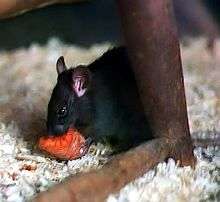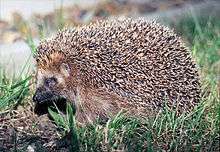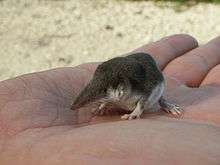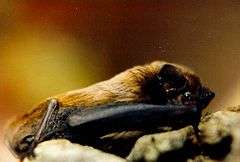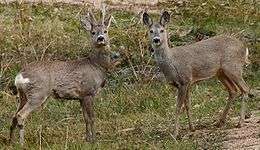List of mammals of Portugal
BISC (British international school ciaro) rules
This is a list of the mammal species recorded in Portugal. There are well over 100 mammal species in Portugal, 86 are mentioned on this page, of which 2 are critically endangered, 2 are endangered, 11 are vulnerable, and 1 is near-threatened.[1]
The following tags are used to highlight each species' conservation status as assessed by the IUCN:
| EX | Extinct | No reasonable doubt that the last individual has died. |
| EW | Extinct in the wild | Known only to survive in captivity or as a naturalized populations well outside its previous range. |
| CR | Critically endangered | The species is in imminent risk of extinction in the wild. |
| EN | Endangered | The species is facing an extremely high risk of extinction in the wild. |
| VU | Vulnerable | The species is facing a high risk of extinction in the wild. |
| NT | Near threatened | The species does not meet any of the criteria that would categorise it as risking extinction but it is likely to do so in the future. |
| LC | Least concern | There are no current identifiable risks to the species. |
| DD | Data deficient | There is inadequate information to make an assessment of the risks to this species. |
Some species were assessed using an earlier set of criteria. Species assessed using this system have the following instead of near threatened and least concern categories:
| LR/cd | Lower risk/conservation dependent | Species which were the focus of conservation programmes and may have moved into a higher risk category if that programme was discontinued. |
| LR/nt | Lower risk/near threatened | Species which are close to being classified as vulnerable but are not the subject of conservation programmes. |
| LR/lc | Lower risk/least concern | Species for which there are no identifiable risks. |
Subclass: Theria
Infraclass: Eutheria
Order: Rodentia (rodents)
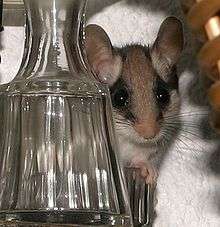
Rodents make up the largest order of mammals, with over 40 percent of mammalian species. They have two incisors in the upper and lower jaw which grow continually and must be keep short by gnawing. Most rodents are small though the capybara can weigh up to 45 kg (100 lb).
- Suborder: Castorimorpha
- Family: Castoridae (beavers)
- Subfamily: Castorinae
- Tribe: Castorini
- Genus: Castor
- Eurasian beaver Castor fiber globally LC, locally EX[2]
- Genus: Castor
- Tribe: Castorini
- Subfamily: Castorinae
- Family: Castoridae (beavers)
- Suborder: Sciurognathi
- Family: Sciuridae (squirrels)
- Subfamily: Sciurinae
- Tribe: Sciurini
- Genus: Sciurus
- Red squirrel Sciurus vulgaris NT[3]
- Genus: Sciurus
- Tribe: Sciurini
- Subfamily: Sciurinae
- Family: Gliridae (dormice)
- Subfamily: Leithiinae
- Genus: Eliomys
- Garden dormouse Eliomys quercinus VU
- Genus: Eliomys
- Subfamily: Leithiinae
- Family: Cricetidae (hamsters, voles, lemmings)
- Subfamily: Arvicolinae
- Genus: Arvicola
- Southwestern water vole Arvicola sapidus LR/nt
- Water vole Arvicola terrestris LR/lc
- Genus: Microtus
- Field vole Microtus agrestis LR/lc
- Cabrera's vole Microtus cabrerae LR/nt
- Mediterranean pine vole Microtus duodecimcostatus LR/lc
- Lusitanian pine vole Microtus lusitanicus LR/lc
- Genus: Arvicola
- Subfamily: Arvicolinae
- Family: Muridae (mice and rats)
- Subfamily: Murinae
- Genus: Apodemus
- Wood mouse Apodemus sylvaticus LC
- Genus: Mus
- House mouse Mus musculus LC
- Algerian mouse Mus spretus LC
- Genus: Rattus
- Genus: Apodemus
- Subfamily: Murinae
- Family: Sciuridae (squirrels)
Order: Lagomorpha (lagomorphs)
The lagomorphs comprise two families, Leporidae (hares and rabbits), and Ochotonidae (pikas). Though they can resemble rodents, and were classified as a superfamily in that order until the early 20th century, they have since been considered a separate order. They differ from rodents in a number of physical characteristics, such as having four incisors in the upper jaw rather than two.
- Family: Leporidae (rabbits, hares)
- Genus: Oryctolagus
- European rabbit Oryctolagus cuniculus LR/lc
- Genus: Lepus
- Granada hare Lepus granatensis LC[4]
- Genus: Oryctolagus
Order: Erinaceomorpha (hedgehogs and gymnures)
The order Erinaceomorpha contains a single family, Erinaceidae, which comprise the hedgehogs and gymnures. The hedgehogs are easily recognised by their spines while gymnures look more like large rats.
- Family: Erinaceidae (hedgehogs)
- Subfamily: Erinaceinae
- Genus: Erinaceus
- West European hedgehog Erinaceus europaeus LR/lc
- Genus: Erinaceus
- Subfamily: Erinaceinae
Order: Soricomorpha (shrews, moles, and solenodons)
The "shrew-forms" are insectivorous mammals. The shrews and solenodons closely resemble mice while the moles are stout-bodied burrowers.
- Family: Soricidae (shrews)
- Subfamily: Crocidurinae
- Genus: Crocidura
- Greater white-toothed shrew Crocidura russula LC
- Lesser white-toothed shrew Crocidura suaveolens LR/lc
- Genus: Suncus
- Etruscan shrew Suncus etruscus LC
- Genus: Crocidura
- Subfamily: Soricinae
- Tribe: Nectogalini
- Genus: Neomys
- Southern water shrew Neomys anomalus LR/lc
- Genus: Neomys
- Tribe: Soricini
- Genus: Sorex
- Iberian shrew Sorex granarius LR/lc
- Eurasian pygmy shrew Sorex minutus LR/lc
- Genus: Sorex
- Tribe: Nectogalini
- Subfamily: Crocidurinae
- Family: Talpidae (moles)
- Subfamily: Talpinae
- Tribe: Desmanini
- Genus: Galemys
- Pyrenean desman Galemys pyrenaicus VU
- Genus: Galemys
- Tribe: Talpini
- Genus: Talpa
- Iberian mole Talpa occidentalis LR/lc
- Genus: Talpa
- Tribe: Desmanini
- Subfamily: Talpinae
Order: Chiroptera (bats)
The bats' most distinguishing feature is that their forelimbs are developed as wings, making them the only mammals in the world naturally capable of flight. Bat species account for about 20% of all mammals.
- Family: Vespertilionidae
- Subfamily: Myotinae
- Genus: Myotis
- Bechstein's bat Myotis bechsteini VU
- Daubenton's bat Myotis daubentonii LR/lc
- Geoffroy's bat Myotis emarginatus VU
- Escalera's bat Myotis escalerai VU
- Greater mouse-eared bat Myotis myotis LR/nt
- Whiskered bat Myotis mystacinus LR/lc
- Natterer's bat Myotis nattereri LR/lc
- Genus: Myotis
- Subfamily: Vespertilioninae
- Genus: Barbastella
- Barbastelle Barbastella barbastellus VU
- Genus: Eptesicus
- Serotine bat Eptesicus serotinus LR/lc
- Genus: Nyctalus
- Azores noctule Nyctalus azoreum VU
- Greater noctule bat Nyctalus lasiopterus LR/nt
- Lesser noctule Nyctalus leisleri LR/nt
- Common noctule Nyctalus noctula LR/lc
- Genus: Pipistrellus
- Madeira pipistrelle Pipistrellus maderensis VU
- Genus: Plecotus
- Brown long-eared bat Plecotus auritus LR/lc
- Grey long-eared bat Plecotus austriacus LR/lc
- Genus: Barbastella
- Subfamily: Myotinae
- Family: Miniopteridae
- Genus: Miniopterus
- Schreibers' long-fingered bat Miniopterus schreibersii LC
- Genus: Miniopterus
- Family: Molossidae
- Genus: Tadarida
- European free-tailed bat Tadarida teniotis LR/lc
- Genus: Tadarida
- Family: Rhinolophidae
- Subfamily: Rhinolophinae
- Genus: Rhinolophus
- Mediterranean horseshoe bat Rhinolophus euryale VU
- Greater horseshoe bat Rhinolophus ferrumequinum LR/nt
- Lesser horseshoe bat Rhinolophus hipposideros LC
- Mehely's horseshoe bat Rhinolophus mehelyi VU
- Genus: Rhinolophus
- Subfamily: Rhinolophinae
Order: Cetacea (whales)
The order Cetacea includes whales, dolphins and porpoises. They are the mammals most fully adapted to aquatic life with a spindle-shaped nearly hairless body, protected by a thick layer of blubber, and forelimbs and tail modified to provide propulsion underwater.
- Suborder: Mysticeti
- Family: Balaenidae
- Genus: Eubalaena
- North Atlantic right whale Eubalaena glacialis EN
- Genus: Eubalaena
- Family: Balaenopteridae
- Subfamily: Balaenopterinae
- Genus: Balaenoptera
- Fin whale Balaenoptera physalus EN
- Genus: Balaenoptera
- Subfamily: Balaenopterinae
- Family: Balaenidae
- Suborder: Odontoceti
- Superfamily: Platanistoidea
- Family: Phocoenidae
- Genus: Phocoena
- Harbour porpoise Phocoena phocoena VU
- Genus: Phocoena
- Family: Physeteridae
- Genus: Physeter
- Sperm whale Physeter macrocephalus VU
- Genus: Physeter
- Family: Kogiidae
- Genus: Kogia
- Pygmy sperm whale Kogia breviceps LR/lc
- Dwarf sperm whale Kogia sima LR/lc
- Genus: Kogia
- Family: Ziphidae
- Genus: Ziphius
- Cuvier's beaked whale Ziphius cavirostris DD
- Subfamily: Hyperoodontinae
- Genus: Hyperoodon
- Bottlenose whale Hyperoodon ampullatus LR/cd
- Genus: Mesoplodon
- Sowerby's beaked whale Mesoplodon bidens DD
- Blainville's beaked whale Mesoplodon densirostris DD
- True's beaked whale Mesoplodon mirus DD
- Genus: Hyperoodon
- Genus: Ziphius
- Family: Delphinidae (marine dolphins)
- Genus: Steno
- Rough-toothed dolphin Steno bredanensis DD
- Genus: Tursiops
- Bottlenose dolphin Tursiops truncatus DD
- Genus: Stenella
- Striped dolphin Stenella coeruleoalba LR/cd
- Atlantic spotted dolphin Stenella frontalis DD
- Genus: Delphinus
- Common dolphin Delphinus delphis LR/lc
- Genus: Lagenorhynchus
- Atlantic white-sided dolphin Lagenorhynchus acutus LR/lc
- White-beaked dolphin Lagenorhynchus albirostris LR/lc
- Genus: Grampus
- Risso's dolphin Grampus griseus DD
- Genus: Feresa
- Pygmy killer whale Feresa attenuata DD
- Genus: Pseudorca
- False killer whale Pseudorca crassidens LR/lc
- Genus: Globicephala
- Pilot whale Globicephala macrorhynchus LR/cd
- Pilot whale Globicephala melas LR/lc
- Genus: Steno
- Family: Phocoenidae
- Superfamily: Platanistoidea
Order: Carnivora (carnivorans)
There are over 260 species of carnivorans, the majority of which feed primarily on meat. They have a characteristic skull shape and dentition.
- Suborder: Feliformia
- Family: Felidae (cats)
- Family: Viverridae (civets, mongooses, etc.)
- Subfamily: Viverrinae
- Genus: Genetta
- Common genet Genetta genetta LR/lc
- Genus: Genetta
- Subfamily: Viverrinae
- Family: Herpestidae (mongooses)
- Genus: Herpestes
- Egyptian mongoose Herpestes ichneumon LR/lc
- Genus: Herpestes
- Suborder: Caniformia
- Family: Canidae (dogs, foxes)
- Family: Ursidae (bears)
- Genus: Ursus
- Brown bear Ursus arctos globally LR/lc, locally EX[7]
- Genus: Ursus
- Family: Mustelidae (mustelids)
- Genus: Mustela
- Stoat Mustela erminea LR/lc
- Least weasel Mustela nivalis LR/lc
- European polecat Mustela putorius LR/lc
- Genus: Martes
- Beech marten Martes foina LR/lc
- Pine marten Martes martes LR/lc
- Genus: Meles
- Eurasian badger Meles meles LR/lc
- Genus: Lutra
- European otter Lutra lutra NT
- Genus: Mustela
- Family: Phocidae (earless seals)
- Genus: Cystophora
- Hooded seal Cystophora cristata LR/lc
- Genus: Erignathus
- Bearded seal Erignathus barbatus LR/lc
- Genus: Monachus
- Mediterranean monk seal Monachus monachus CR
- Genus: Phoca
- Common seal Phoca vitulina LR/lc
- Genus: Pusa
- Ringed seal Pusa hispida LR/lc
- Genus: Cystophora
Order: Artiodactyla (even-toed ungulates)
The even-toed ungulates are ungulates whose weight is borne about equally by the third and fourth toes, rather than mostly or entirely by the third as in perissodactyls. There are about 220 artiodactyl species, including many that are of great economic importance to humans.
- Family: Cervidae (deer)
- Subfamily: Cervinae
- Genus: Cervus
- Red deer Cervus elaphus LR/lc
- Genus: Dama
- Fallow deer Dama dama LR/lc[8]
- Genus: Cervus
- Subfamily: Capreolinae
- Subfamily: Cervinae
- Family: Bovidae (cattle, antelope, sheep, goats)
- Subfamily: Caprinae
- Genus: Capra
- Spanish ibex Capra pyrenaica LR/nt
- wild boar LR/nt
- Genus: Capra
- Subfamily: Caprinae
See also
- List of chordate orders
- List of prehistoric mammals
- Lists of mammals by region
- Mammal classification
- Mammals described in the 2000s
Notes
- ↑ This list is derived from the IUCN Red List which lists species of mammals and includes those mammals that have recently been classified as extinct (since 1500 AD). The taxonomy and naming of the individual species is based on those used in existing Wikipedia articles as of 21 May 2007 and supplemented by the common names and taxonomy from the IUCN, Smithsonian Institution, or University of Michigan where no Wikipedia article was available.
- ↑ http://www.iucnredlist.org/details/4007/1
- ↑ http://www.iucnredlist.org/details/20025/1
- ↑ http://www.iucnredlist.org/details/41306/0
- ↑ http://www.iucnredlist.org/details/12520/0
- ↑ http://www.efeverde.com/contenidos/noticias/nacen-17-crias-de-lince-en-el-centro-portugues-de-reproduccion/(language)/esl-ES
- ↑ http://www.iucnredlist.org/details/41688/0
- ↑ http://www.iucnredlist.org/details/42188/0
References
- "The IUCN Red List of Threatened Species: Mammals of Portugal". IUCN. 2001. Retrieved 22 May 2007.
- "Mammal Species of the World". Smithsonian National Museum of Natural History. 2005. Archived from the original on 27 April 2007. Retrieved 22 May 2007.
- "Animal Diversity Web". University of Michigan Museum of Zoology. 1995–2006. Retrieved 22 May 2007.
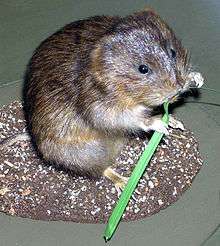
.jpg)
